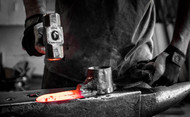Red Pig Tools became a fixture in the area, manufacturing and selling its tools and taking on all sorts of custom jobs, from repairs and sharpening to custom-making specialty tools. The Denmans also liked to frequent garden fairs and local garden-club events. At the 2017 Spring Garden Show in Canby, Oregon,they were approached by a young man named Seth Pauley. Pauley was something of a polymath—he had taught creative writing and literature at Temple University, founded several small businesses, and studied ceramics under the famed Mahmoud Baghaeian, among other endeavors—and was immediately fascinated by the Denmans and their high-quality, hand-crafted tools.
Pauley first proposed an idea for tools specifically engineered for women, and while Bob had to decline the project—already in his seventies, he was too busy with the tools he was already making—he offered to teach Seth how to make tools himself. After taking a blacksmithing course to get up to speed, Pauley returned to the Denmans’ shop, eager to learn. As Bob passed on his skills and Seth proved a quick study and a capable maker, their partnership evolved and a way forward for the company appeared.
“As Bob was getting close to retiring, he started to teach me so I could take over,” Pauley explains. The transition has been successful, to say the least.
“Over the course of a year I make between 250 and 400 different types of tools,” Pauley says. “We make several hundred to a couple thousand of a few tools that are very common—the range of trowels and things like that. But there’s a lot of things that I’ll make 10 of a year, or 50 of a year, because there’s not the demand for them—which is a nice niche to be in, because people discover tools that they thought could no longer be bought.”



